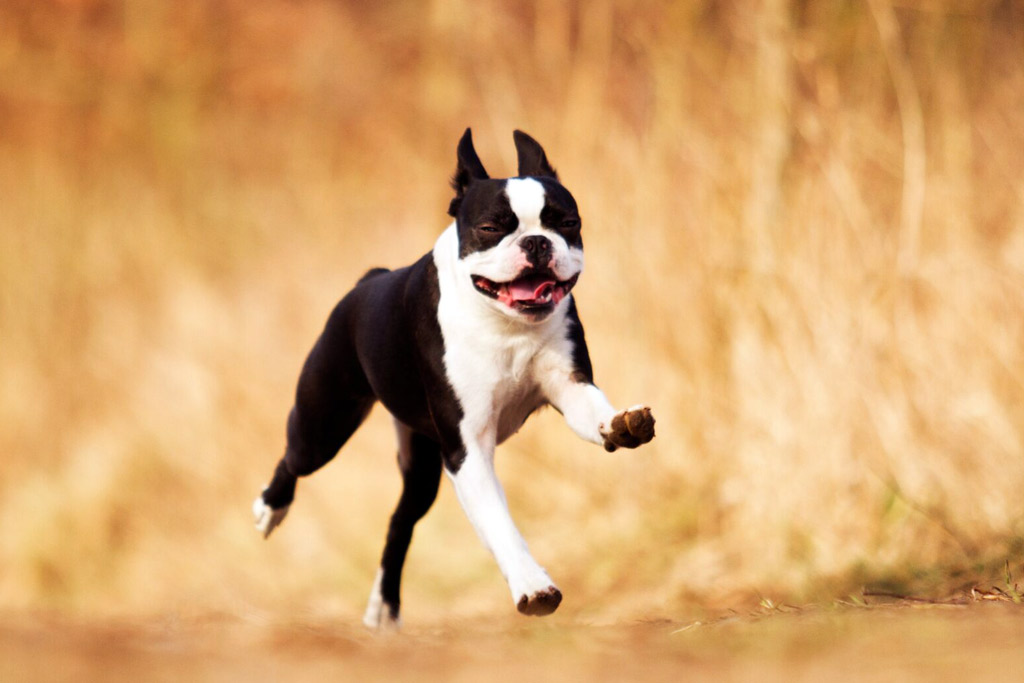
You’re convinced on getting a Boston Terrier, or you’re proud, Boston puppy owner. This makes teaching and training your pooch a great next step, which brings the question:
What should I know about training a Boston Terrier?
Although they can be stubborn at times, Boston Terriers are easy to train. Since they are sensitive to punishment, reward-based training method works best for them.
Continue reading for good training basics, the dos and don’ts, and helpful tips during training sessions with your Boston.
Boston Terrier Trainability
Are Boston Terriers easy to train?
According to AKC, Boston Terriers are easy to train. Regardless of being stubborn at times, they are always eager to please their owners.
The first step towards training, which is usually skipped, is to understand your dog breed’s temperament.
This is the foundation for successful training. And during the training sessions, you will start discovering your pup’s own personality too!
Here are some characteristics of Boston Terriers:
- They are easy to train.
- They are considered to be intelligent.
- Some can be stubborn.
- They are eager to please their owners.
- This breed has a very high wanderlust potential.
- Bostons have high energy levels.
- And they are vigorous since they have very high-intensity levels (i.e., a short outburst of energy).
- They are very playful too.
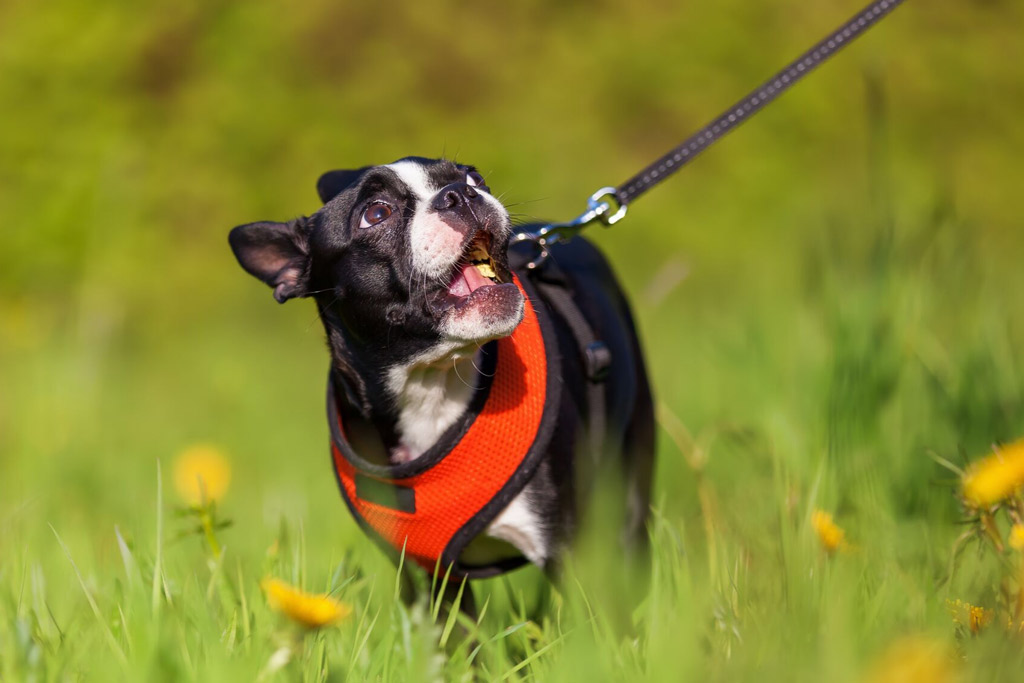
Boston Terrier Training Method
Personally, I prefer positive reinforcement training. Reward-based training is not only more successful than other training methods but also means you and your dog can work towards a positive relationship that will serve as a good foundation for future training.
So, I definitely think that it’s the best method to train Bostons Terriers.
The main reason is that Bostons are sensitive to your tone of voice, which means that negative reinforcement won’t get you the results you want. Using a harsh tone and punishment can make them shut down.
As a result, Boston Terrier training should be low-key, positive and motivational. That’s why positive reinforcement works great, especially when combined with food rewards (Bostons are food-motivated doggies) and continuous praise.
This method consists of rewarding your dog’s good behaviour immediately after it happens with praise, a caress or a healthy treat. The big takeaway of this method is that it encourages your dog to repeat good behaviour.
Reward-based training also involves generally ignoring any ‘unwanted’ behaviours. If dogs are not rewarded (i.e. receives no attention or treats) for a certain behaviour, then they tend to stop doing it.
Insider Tip: Dogs interpret any attention (eye-contact, yelling or getting angry) as a reinforcement of behaviour. They will perceive a reaction from you as getting attention, and any form of attention/reaction from the owner is better than no reaction at all.
That’s why I want to point out that shouting “no!” or “bad dog!” rarely works in the long term. Dogs won’t understand that they are doing something wrong if they get attention from you.
Also, Bostons can be stubborn at times, so persistence and consistency are key during training. All dogs thrive on following a routine that stays consistent.
Finally, training should be fun!
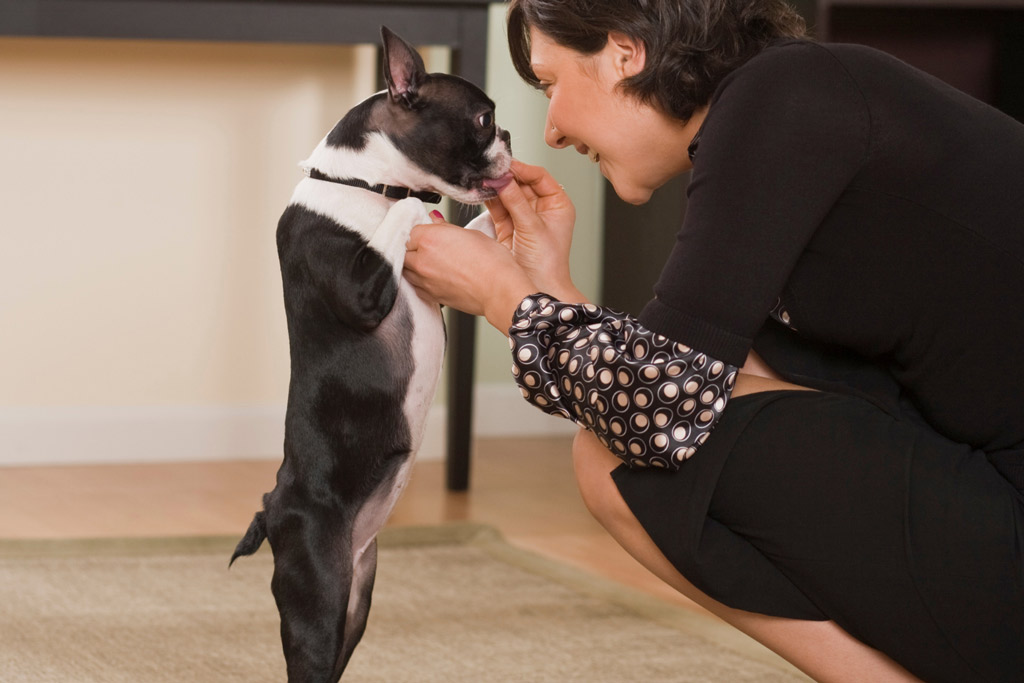
Boston Terrier Training Basics
Training and socialization are among the Boston Terrier Care pillars for a healthy and happy dog. That’s why it’s important to start training your Boston as soon as possible, whether he is a puppy or an adult dog.
So, where do you start?
Housebreaking (or house-training) your dog is the first step of your Boston’s training. It will lay the foundation and also prepare your dog for a lifetime of good behaviour.
House training consists of 5 key areas:
- Crate training: It helps with potty training, getting your pooch used to travelling in a carrier and as an open den where your pup can feel safe and can also retire into. Refer to Boston Terrier Crate Training blog post.
- Leash training: Every dog should learn to walk on a leash. Using a harness and a leash appropriate to your Boston’s strength, size and age is very important as it makes a huge difference. Check our Boston Terrier Leash Training Without Pulling blog post for more.
- Potty training: Choosing your dog’s toilet spot is very helpful to establish a routine. Plus, the timetable instructs him that there are times for everything: eat, play, walk, nap, and eliminate. Go to Boston Terrier Potty Training for a step-by-step guide.
- Basic commands: It is important that your puppy learns to follow your command and obedience. You should begin basic training commands like sit, down, come, stay, and leave it. Just take one command at a time and build upon them. Refer to Boston Terrier Obedience Training for a basic command guide.
- Socialization: It means training your puppy or adult dog to be comfortable around new people, animals, and various places by exposing him to these things. You should continue with social exposure throughout a dog’s life. Go to Boston Terrier Socialization guide for getting started.
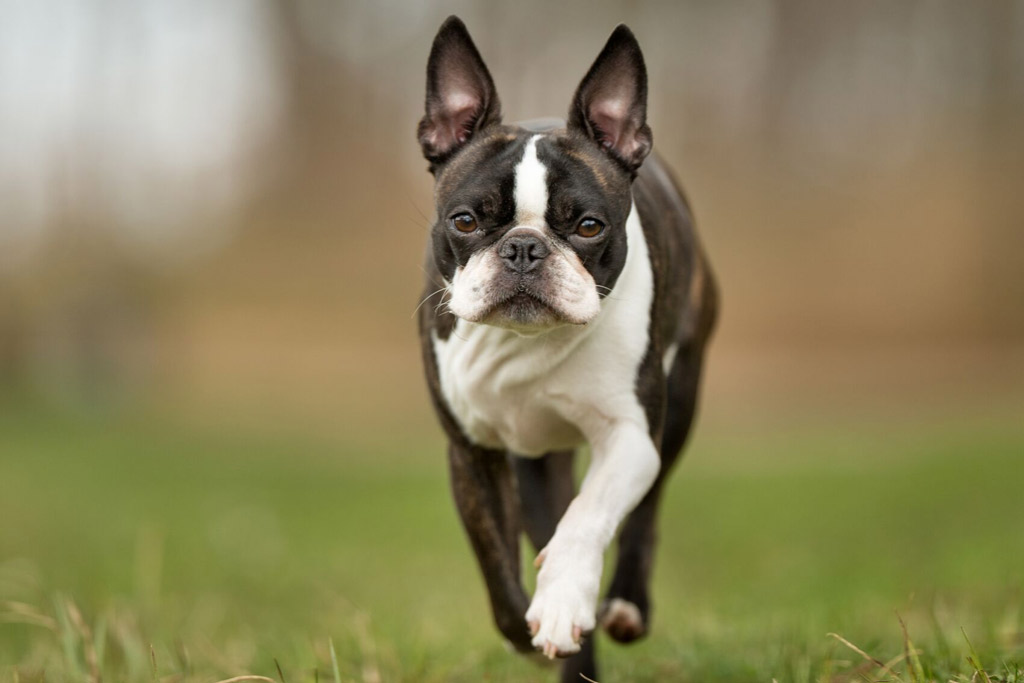
Boston Terrier Training Sessions
At first, dog training can be pretty overwhelming, especially if this is your first dog.
The best help is to just take it one step at a time:
- Let your dog assimilate the new information.
- And give yourself the time to feel confident about how you are approaching your doggy’s training.
You can start with 5-10 minute training sessions at a time, and build into a 15-minute training routine.
Before Training
There are two questions that you want to answer before starting to train your Boston:
- Does my dog have any previous training?
- Where should I train my dog?
Determine a Starting Point
Before starting to train your pooch, find out if he has received previous training (this mostly applies for rescue dogs).
You might discover your dog can already follow basic commands or you have been informed that your new dog is fully house-trained. However, it is often worth refreshing their memory, especially since they need to get used to their new home.
Training an adult dog will take a little longer, but dogs are more than capable of learning new commands and tricks. 🙂
Establish Where To Train
But before getting started, have you paid attention to what surrounds you while you attempt to train your pooch?
Parks and busy neighbourhoods are too distracting. Plus, Bostons have a very high wanderlust potential, so enclosed spaces are best to train them when getting started.
This means a boring, non-distracting environment makes for a great training space.
An empty room is ideal, but if we are being realistic, it’s unlikely you’ll have an empty room in your home. So instead, a room with no toys, attractive objects for your dog or other people will do.
Your goal is to grab your furry friend’s attention easily.
However, don’t forget to have some treats at hand to reward the progress your Boston Terrier makes. Positive-reward-based training encourages good behaviour!
Also, it’s important to:
- Determine your dog’s training starting point.
- Establish a training schedule.
- And get some useful training equipment.
Continue reading to find out about these three key points!
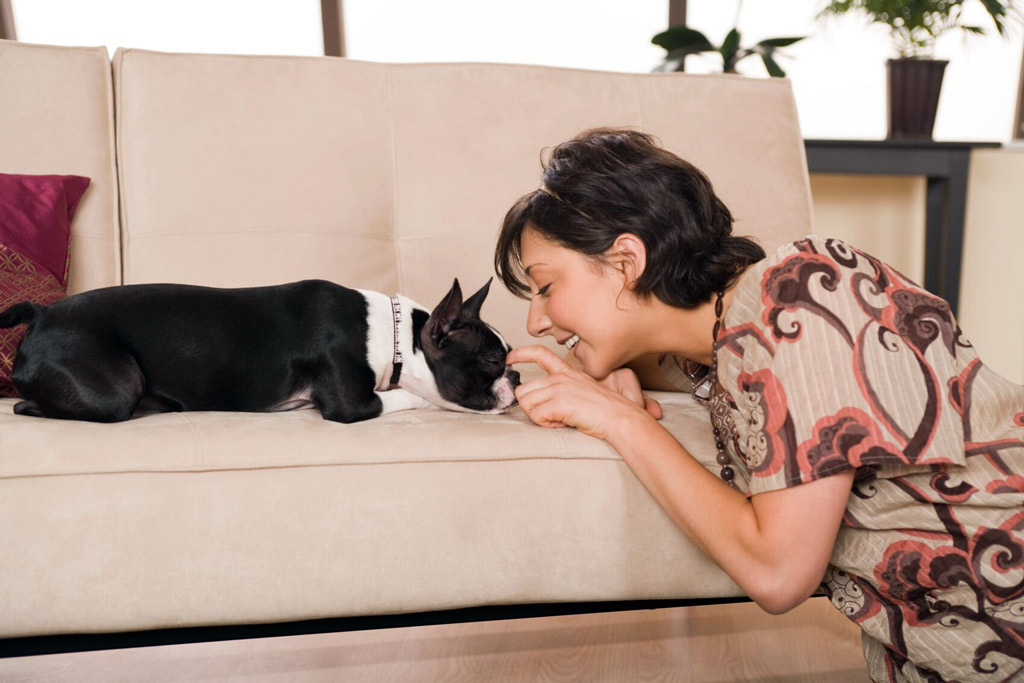
When Training
Do’s:
- Start training in a boring environment.
- Do one goal at a time.
- Communicate clearly using the same commands and gestures.
- Stay consistent with your dog’s training sessions.
- Regard your Boston’s good behaviour every time with praise and/or a treat.
- Finish each session on a good note, so your pooch associates training with having fun with you!
Don’ts:
- Avoid training your pooch for long periods since dogs have short attention spans, i.e., they won’t be able to focus for more than a few minutes at a time.
- Don’t reprimand your pup for misbehaving, he won’t understand. This will only get him discouraged and upset.
- Rushing doesn’t help. Take it slow, every dog has his learning pace.
- Stay patient and consistent. Let your pup learn one command at a time and take breaks when necessary.
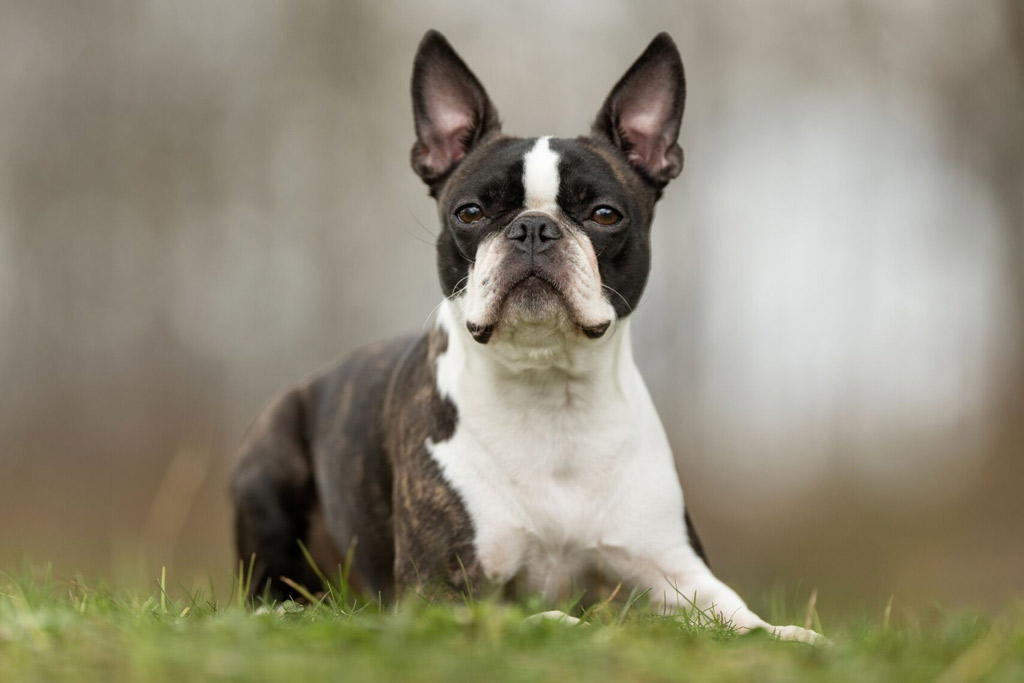
Boston Terrier Training Schedule
Every Boston Terrier has his learning rhythm, but all need consistency in their training. Dog training isn’t an overnight process, and sometimes you might feel that you aren’t making much progress. But don’t get discouraged.
Being consistent is one of the most important parts of dog training. Your Boston will learn to follow commands more quickly if you train him and positively reinforce appropriate behaviour consistently, rather than once in a while.
Training is an important task of your dog’s schedule, alongside mealtimes, exercise (walks), playtime, grooming and sleep. Dogs thrive on routine. Once you establish a daily routine, remain consistent on both weekdays and weekends as much as possible. This will help your dog know what to expect and when.
Also, it’s beneficial for housetraining since your dog will begin to learn the exact times he can go outside. For instance, after every meal, he goes for a potty walk to relieve himself.
For the Boston Terrier puppy training schedule, check Boston Terrier Potty Training and Boston Terrier Crate Training blog posts.
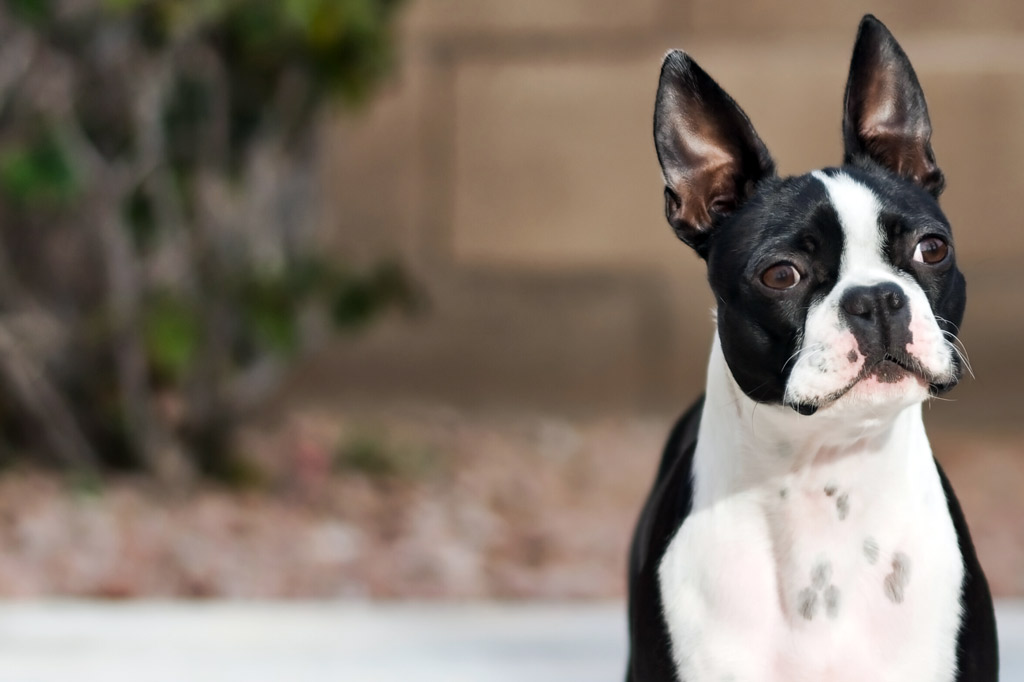
Boston Terrier Training Essentials
There are some props that will help you and your Boston Terrier when you begin house-training your pooch, such as:
- A dog harness: Dogs walk better on the lead (i.e. without pulling) if they wear a harness. Also, it gives you better control of your dog when walking him.
- A dog leash: A short fixed-length leash is ideal to train your dog to walk by your side. However, you might want to use a long lead to train your dog to fetch and come back to you.
- Dog treats: High-quality treats are a great way to reward your dog, just don’t overfeed him. Check our Boston Terrier Treats blog post for ideas and my favourite dog treats for healthy alternatives.
- A dog clicker: A sound-emitting device that aims to signal your dog that he has done the right thing.
- A crate: Also referred to as a dog cage or indoor kennel is designed as a safe, secure area that a dog can go into for short periods of time. (Refer to Crate Training further down).
*Note: you can find all these props in Amazon.
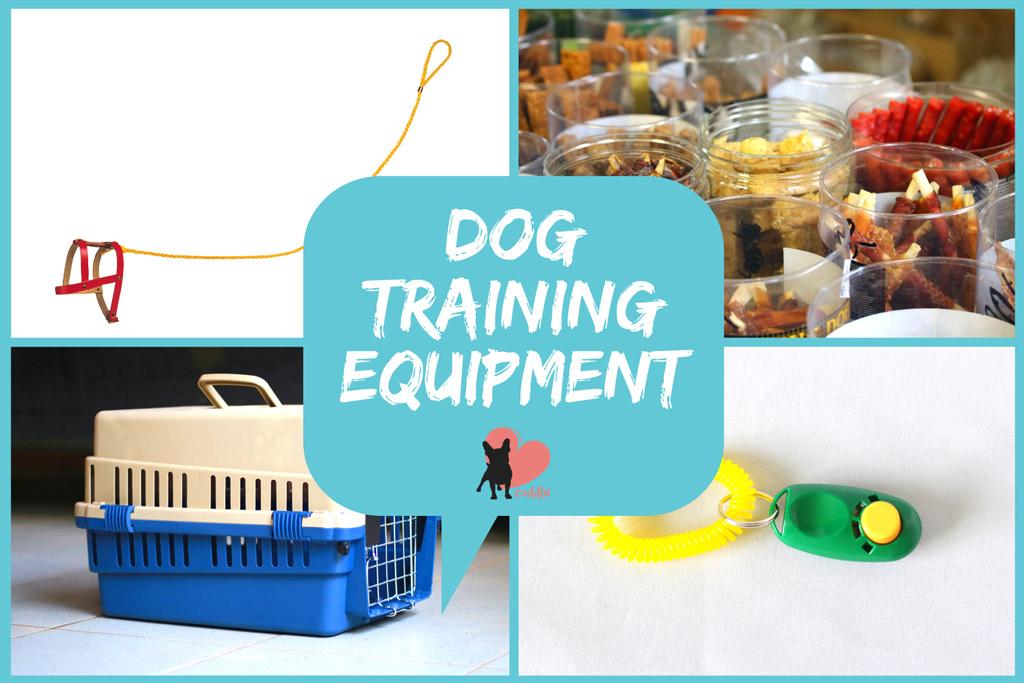
What’s Next
After talking about reward-based training and how to implement it in an enjoyable way…
You are probably facing the 3 most common challenges with your Boston Terrier:
- Potty training.
- Leash pulling.
- Biting/nipping.
If you are having some trouble, I may be able to help with that. Click here to visit our Dog Training Essentials, where you will get a 3-part mini audio series + the everyday resource used by a well-known dog trainer.
You can also get this using the button below. Happy training! 😉
